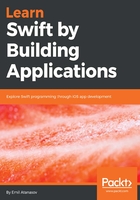
How to tackle huge problems – bottom-up versus top-down
Step-by-step through this book, we will start solving problems until we can write a fully-working mobile app. It's not an easy task, but we can take two different approaches when trying to solve a huge problem (such as writing a mobile app). The first one is top-down. This technique starts from the top with the main problem, and breaks it down into smaller problems and functions. Once we reach something unclear, something which is not well defined that we should implement, then we define a new function, but we won't continue developing the exact implementation of this part of the app immediately. Let's assume that we are trying to develop a mobile app with three screens. The first one displays a list of news. The second one renders specific news, and the last one shows information about our application.
If we apply the top-down approach, then we will have the following abstract process. We start from the biggest problem: how to develop an app with three screens. Then, we break this huge task down into three sub-tasks with their respective functions. Those functions are empty functions. The first one will be responsible for creating the first screen, the second one should create the detailed news presentation, and the third should define the last screen. By doing this, we have decomposed the main problem into three smaller ones. These new functions are empty, but at a later phase we will implement each one of them. We can start with the first one: we define another help function which creates the list of news, and another function which fetches the news from an internet address. Now it doesn't look really hard to define those functions. We will learn how to do this throughout the book, but the general idea is to break down each problem into smaller ones until you reach a state where you can solve them without any hassle. In the end, the main problem will be solved, because all parts that have been decomposed are already working, and the final result will be a fully-working mobile application.
The other approach is bottom-up, which does things in reverse. It's more like working with Lego, but you first go and build many small building blocks, which you combine together until you manage to build a solution to the whole problem; in our case, until you build a working mobile app. Abstractly, we develop simple enough functions that we can implement to solve small problems. Then we combine those into bigger chunks. Those bigger chunks are put together in even bigger and more complex functions or app parts, until we define the final working app.
Neither of these two approaches is the best. Every developer prefers to use a nice mixture of both techniques, which leads to the final result—a working app.
If top-down, or bottom-up, is used on its own, it is not a silver bullet. Try to use top-down and bottom-up together and you will find the solution easier.
Just tweak your approach based on what you know at the moment, and what you have.